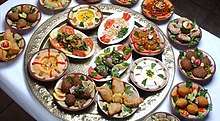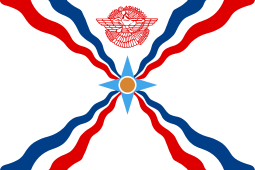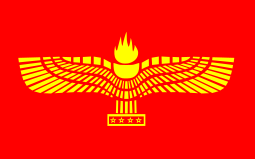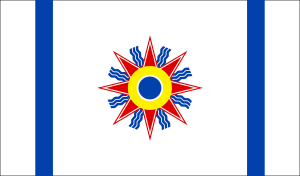Assyrian culture
The culture of the Assyrians is both distinct from those of neighbouring ethnic groups as well as ancient. Many Assyrians (estimates of fluent speakers range from 500,000) still speak, read and write various Akkadian-influenced dialects of Eastern Aramaic, labelled by linguists as Northeastern Neo-Aramaic and Central Neo-Aramaic. They are predominantly adherents of several denominations of Syriac Christianity,[1] notably the Ancient Church of the East, the Assyrian Church of the East, the Syriac Catholic Church and the Syriac Orthodox Church. Some are followers of the Assyrian Pentecostal Church and Assyrian Evangelical Church. A minority are secular or irreligious.
| Assyrian people |
|---|
 |
| Culture |
| Music |
| Language |
| Cuisine |
| Folk Dance |
| Religion |
| Clothing |
| Settlements |
| Tribes |
Annual celebrations
Assyrians celebrate many different kinds of traditions within their communities, with the majority of the traditions being tied to religion some way. Some include feast days (Syriac: hareh) for different patron saints, the Rogation of the Ninevites (ܒܥܘܬܐ ܕܢܝܢܘܝ̈ܐ, Baʿutha d-Ninwaye), Ascension day (Kalo d-Sulaqa), and the most popular, the Kha b-Nisan (ܚܕ ܒܢܝܣܢ, 'First of April'). Some of these traditions have been practised by the Assyrians for well over 1,500 years.
Yawma d-Sahdhe ('Martyrs Day')

The Simele massacre (ܦܪܡܬܐ ܕܣܡܠܐ, Pramta d-Simmele) was the first of many massacres committed by the Iraqi government during the systematic targeting of the Assyrians of northern Iraq in August 1933. The killing spree that continued among 63 Assyrian villages in the Dohuk and Nineveh districts led to the deaths of an estimated 3,000 Assyrians.[2][3]
August 7 became known as Martyrs Day (ܝܘܡܐ ܕܣܗܕ̈ܐ, Yawma d-Sahdhe) or National Day of Mourning by the Assyrian community in memory of the Simele massacre as it was declared by the Assyrian Universal Alliance in 1970. In 2004, the Syrian government banned the Assyrian political organization and the Assyrian community of Syria from commemorating the event, and threatened arrests if any were to break the ban.[4]
On August 7, Assyrians in the homeland and in the diaspora gather together and share poems about the incident, reveal new artwork, etc.
Resha d-Nisan ('Start of Spring' or 'Assyrian New Year')
The Assyrian new year festival, known as Resha d-Nisan (literally 'Head of April'), is celebrated on the first day of spring and continues for 12 days.
Celebrations involve holding parades and parties, gathering in clubs and social institutions and listening to poets reciting "the Story of Creation." The men and women wear traditional clothes and dance in parks for hours.
After the formation of the Turkish state in the 1920s, Resha d-Nisan along with the Kurdish Nowruz were banned from being celebrated in public. Assyrians in Turkey were first allowed to publicly celebrate Resha d-Nisan in 2006, after organisers received permission from the government to stage the event, in light of democratic reforms adopted in support of Turkey's EU membership bid.[5]
Baʿutha d-Ninwaye ('Fast of Nineveh')
The Fast of Nineveh (ܒܥܘܬܐ ܕܢܝܢܘܝ̈ܐ, Baʿutha d-Ninwaye, literally 'Rogation of the Ninevites') is a three-day celebration that is composed of prayers and fasting that Assyrians of the Ancient Church of the East, the Assyrian Church of the East, the Chaldean Catholic Church, the Syriac Orthodox Church and the Syriac Catholic Church (as well as The Malankara Orthodox Syrian Church and Syro-Malankara Catholic Church in India) consider sacred. The word baʿutha (ܒܥܘܬܐ) is a Syriac word for 'pleading,' and from this meaning we receive the title of this commemoration.
This annual observance occurs exactly three weeks before the start of Lent. This tradition has been practised by the Syriac Christians since the 6th century.
According to legend, in the 6th century, a plague inflicted the Nineveh plains (in modern-day northern Iraq). The plague was devastating the city and the villages surrounding it, and out of desperation the people ran to their bishop to find a solution. The bishop sought help through the scriptures and came upon the story of Jonah in the Old Testament.

In the Old Testament story, God sent the prophet Jonah to warn the city of Nineveh of great destruction unless they repent for their sins: "the word of the Lord came to Jonah the son of Amathi, saying: Arise and go to Nineveh, the great city, and preach in it: for the wickedness thereof is come up before me." Jonah did not wish for Nineveh to be saved since they (the people of Nineveh) were the enemies of Israel and preferred Nineveh to be destroyed. Instead of listening to God, Jonah fled to Tarshish, across the Mediterranean Sea. During his voyage, a violent storm occurred. The other sailors feared the boat would be completely destroyed and kill everyone if they did not get rid of Jonah, so they decided to throw Jonah overboard. As soon as Jonah hit the water, a giant fish swallowed Jonah whole. Jonah found himself in the dark stomach of the fish. Jonah began to pray earnestly for God to save him and, for three days and nights, Jonah prayed and asked for forgiveness for his disobedience.
On the third night the fish became violently ill and swam near to the seashore where it vomited Jonah onto the beach. Jonah, thankful that he had been spared, started on the journey to Nineveh. Reaching the walls of Nineveh, he began preaching to people as he walked through its streets, "In forty days God will destroy this city because of your great sins." The king of Assyria became disturbed at the message that Jonah preached. He called his people together and commanded them to wear sackcloth clothing and to let neither man nor animals eat as the people prayed and repented of their wicked ways. All of the people of the city cried and prayed and asked God to forgive them for their sins. The city then was not destroyed.
Upon looking at the story, the bishop therefore ordered a three-day fast to ask for God's forgiveness. At the end of the fast, the plague had miraculously stopped, and on the 4th day, the people rejoiced.
To this day, Assyrians of all three denominations—Catholic, Orthodox and Church of the East—still observe the fast for three days each year.
Somikka ('Holy Halloween')
Somikka shares some common aspects with the American festival of Halloween, but its meaning is different. The main purpose of Somikka is to motivate and discipline Assyrian children to observe Lent by scaring them into fasting, when people would abstain from eating animal products for the seven weeks preceding Easter.
The evening before the fast begins, what is called 'Somikka night' (Layle d-Somikka), small groups of young men dress in Halloween-like clothes, wear masks and also carry accessories such as wooden swords and shields. These men then would knock on Assyrian homes and scare the children into fasting. The parents in return would give the young men "Somikka money" (or, traditionally, food items) and tell their children that this was to bribe Somikka off them. They would also warn them that if they broke their fast during Lent, Somikka would come and punish them with misery and a hard life. This form of discipline is seen as part of raising children to grow up into God-fearing and upright adults.
Assyrian villages in Urmia had another custom relating to Lent. The head of every family would stick seven coloured feathers into a large onion, the feathers representing the seven weeks of fasting. He would then tie the feathered onion with a string and hang it from the ceiling of their living room, where it would spin every time there was a draft when the door was opened. This attracted attention and served to remind the children of the fast. Every Sunday night he would remove, ceremoniously, one feather to indicate that one week of fasting was over, until all the feathers were gone by Easter night, the last day of fasting.
Kalo d-Sulaqa ('Bride of the Ascension')
The legend of Kalo d-Sulaqa tells of a young Malik Shalita, governor of the Assyrian homeland’s capital Mosul, who was first noticed by Tamerlane after he had successfully fought and defeated his initial attack on the city. The battle is then described as freedom fighters, both Christian and Muslim, defended against the Mongol attack.
It was during this time that, according to legend, Malik Shalita’s wife organised Assyrian women dressed in white, and was given the responsibility to collect provisions from the nearby towns in order to feed the men fighting at the front. Having heard the fate that had befallen their countrymen in Tikrit and Mardin, they knew very well the fate in store for them if they were to lose this battle. Instead of running and hiding, the women prepared for the battle and joined the ranks of the defenders against unfavourable odds.
The historical account is in keeping with the legend, as both describe a brutal battle of attrition, in which both men and women joined together and defended themselves against Tamerlane's attack. Malik Shalita and his wife—according to the legend dressed in white—are recorded as having been killed in this battle.
The Assyrian historian Arsanous states that the young boys and girls represent the dead young men and women who ascended to heaven because they died for the cause of Christianity and in defence of their homeland. The tragic nature of the 1401 event had left such an indelible impression on the minds of the survivors that they remembered the final battle and have honoured the memory of the fallen by re-enacting the camaraderie of the Assyrian men and women who died defending their homeland.
There are many traditional practises that Assyrians observe when celebrating Kalo d-Sulaqa (Ascension Day). Most commonly, in Hakkari, prior to the First World War, girls in each village would gather and choose the prettiest one among them to be the Kalo d-Sulaqa ('the Bride of the Ascension') for that year. She would be dressed in a traditional Assyrian wedding costume and then paraded around the village singing and asking for walnuts and raisins, which they would then share amongst themselves in a feast held afterwards in honour of the 'bride.'
Assyrians would celebrate this day like any other feast, with music, dancing, food and drink, but also with a few differences. Apart from the little girls dressed as brides, there was also a custom practised by Assyrians living in Hakkari, where ropes were tied to strong branches of large trees. After this was done, all those present would attempt to climb one, and any not doing so would mean bad luck for them, while anyone reaching the end of the rope and the branch would have the best of luck for the coming year. This was done to represent the Ascension of Jesus and the eventual resurrection of the dead and final judgement. This custom is seldom practised today apart from certain areas in the northernmost extremities of Iraq.
In Urmi, on the other hand, it was customary for the little girls in the villages to dress as brides and when doing their rounds of their villages would also ask for pennies or trinkets. This is a reflection of the generally greater wealth of the Assyrians in the plains of that region.
It is also said that the very same custom was used during fierce battles. Young girls, dressed as brides, were ordered to take provisions to the men fighting on the battlefield. Their mothers, knowing that they may never return, used this custom to instill courage in their young daughters.
In Syria, young girls and boys would join together and form a couple, dressed as bride and groom, and then go from door to door, singing. They were usually rewarded, not with money or candy, but with wheat, rice, fruits, and so on. At the end of the day, the children would go out to a field to cook and eat what they had collected.
This custom, particular to members of the Church of the East and the Chaldean Catholic Church, survives in these communities worldwide and is marked by a party, often women only. It is also a new custom to hold a mock wedding reception complete with khigga, slow dance, dinner, and cake, the only difference being that the bride, groom, best man and maid of honour are all young girls.[6]
Marriage rituals

Assyrian rituals consist of many different types of elements that have shaped today's modern rituals for the past 3,000 years. An Assyrian wedding traditionally lasted a week and consisted of different rituals for each day. Today, weddings in the Assyrian homeland usually last for two to three days while Assyrian weddings in the diaspora about one or two days. During the wedding reception, most women have a handkerchief to dance with different colours and noises to distract evil spirits.
Blanket ritual
A week before the marriage, all the women of the neighbourhood and the women in the family go to the house of the bride and make her a large blanket. Everybody had to make sure they sewed a bit of that blanket. So the needle would be passed from one woman to the other and this way all the women sewed a bit. The younger women would dance around it and the older women would sing and dance khigga. During the party food and sweets are served, and the party ends when the blanket was done.
Khyapta/Zyapta d-Khitna ('Washing/Pushing of the Groom')
Shortly before the wedding, all the groom's male relatives and neighbours go to his house and cut his hair and shave his face. The groom's male relatives wash him from head to toe, symbolically cleansing him of 'evilness.' A young boy is usually bathed first (typically by his mother or aunts), then the groom takes a shower or bath afterwards.
Niqda ('Bridewealth')
Bridewealth is commonly practised, even among those who reside in the Western world. The tradition would involve the bridegroom's family paying the father of the bride. The amount of money of the bridewealth is reached by negotiation between groups of people from both families. The social state of the groom's family influences the amount of the bridewealth that is ought to be paid. When the matter is settled to the contentment of both menages, the groom's father may kiss the hand of the bride's father to express his chivalrous regard and gratitude.[7]
Mpalatta d-Kalo ('Bringing Out of the Bride')
A tradition symbolic of the bride leaving the home of her parents. Usually the bride is in her home and the groom's family visits to take her out of the home and to the church. While in the house, the women sing traditional lilyane while dola ('drum') and zurna ('flute') is played as they dance. Before the bride leaves the house, a member of the bride's non-immediate family stands at the door and receives an amount of money from a member of the grooms family (usually the father or a brother). The amount is decided by whoever is holding the door.
Burakha ('Blessing')
The wedding tradition where the bride and groom are blessed by a priest in a church. The burakha traditionally lasted about four hours, but more recently the event goes for about one hour. Pins in the shape of two crosses are usually placed on the groom's back. There are some details during the ceremony that differ from village to village. To ward off evil spirits, the Assyrians of Baz are known to have someone poke the groom with a needle to ward off any evil spirits while Assyrians from Tyari make noise with the cutting motion of scissors.[8] At the end of the burakha as the bride and groom are coming out of the church, dola and zurna is played while rice, candies, and coins are thrown at the bride and groom and people take part in traditional Assyrian dances.
Henna
Henna is mud-like material that is prepared on the day before the wedding. On the night before, people (traditionally only women) gather at the house of the bride and fill a bowl with henna.
In some areas, whoever holds the bowl with the henna will dance with it around the others. The groom and bride each put a little finger in the bowl where they are tied to each other by a ribbon. In other areas, everyone is given a turn to wrap his finger with henna, and after everyone, the person that is getting henna in his hand starts the chant of praise for the future couple, as everyone else follows him.
Funeral rituals
Traditional
The burial rituals of the Assyrians is described by Surma D'Bait Mar Shimun and the manner by which Assyrians of the highland cared for their dead relatives resemble what Olmsted wrote about how the ancient Assyrian cared for theirs. Surma wrote: "In some districts—as in Tkhuma for instance—food is also placed on the graves and in this valley the graves are often made with a little niche in the side of them both for this purpose and for the putting of the light."[9] About the burial customs of the ancient Assyrians, Olmsted writes: "always the lamp was left in a niche, and even the smoke can still be seen. A large water jar, a jug, and several dishes formed the remainder of the equipment needed for the after-life ..." [10] Surma further adds; On the morning of the resurrection day before day light Assyrians in the highland visited the graves of their loved ones and lighted tapers on their resting site. The usual greeting at this time was "light to your departed".[9]
Contemporary
In the modern tradition, the mourning family host guests in an open house-style just after a loved one passes away. Only bitter coffee and tea are served, showcasing the sorrowful state of the family. Symbolically, some will not drink the coffee in front of them at all. On the funeral day, a memorial mass is held in the church. At the graveyard, the people gather and burn incense around the grave as clergy chant hymns in the Syriac language. The closest female relatives traditionally bewail or lament (bilyaya) in a public display of grief, with some beating their chest, as the casket descends. Other women may sing a dirge or a sentimental threnody (jnana, which are short, rhymed chants) to passionately heighten the mood of the mourning at the cemetery, similar to an Indian oppari. Zurna and dola may be played if the departed is a young, unmarried male.[11]
During all these occasions, everyone is expected to dress in complete black, passively informing the community that they have recently buried a loved one. Following the burial, everyone would return to the church hall for afternoon lunch and eulogy. At the hall, the closest relatives sit on a long table facing the guests (akin to a bridegroom's table at a wedding) as many people walk by before leaving shaking hands, offering their condolences. At the hall, dates and halva may served to offer some "sweetness" in the bitter grieving period. On the third day, mourners would customarily visit the grave site with a pastor to burn incense, symbolising Jesus' triumph over death on the third day, and 40 days after the funeral (representing Jesus ascending to heaven), and in conclusion one year to the date. Mourners also wear only black until the 40 day mark, with no jewellery and would typically not dance or celebrate any major events for one year.[12]
Assyrian names
Many Assyrians traditionally give Aramaic names as well as Biblical (Hebrew and Greek) and Persian names as first names. Beginning in the 19th century with the rise of Assyriology and archaeological excavations of Mesopotamia, many Assyrians began "reviving" Akkadian and Sumerian names used in ancient history and mythology.
Given Names
Some popular male Assyrian given names are: Ashur, George, Gewargis, Hano, Samano, Naramsin, Ramsin, Sargon, Sargis, Ninos, Ramin, Dawid, Benyamin, Banipal, Shmuel, Zaya, Orahim/Avrahim/Oraha, Shimun, Elia, Abgar, Addai/Aday, Apram/Aphrem, Bardaisan, Hunain, Yukhanna, Yonan, Younan, Yatrin, Yoel, Petros/Patrus, Gabriel, Yacob/Yaqub, Eshaya, Nimrud, Daniel, Yousip, Dinkha, Eshai/Ishai, Moushe, Thoma, Tulmay, Yahballaha, Dadisho/Dadishu, Narsai, Ishoyahb, Aho, Isho, Sharbel, Sharo, Sabrisho/Sabrishu, Belo, Eliya, Shalim, Bilgamish, Hammurabi, Sinharib/Sennacherib, Ninsun, Adam, Ashurdan, Ninev/Nineb, Sada, Shima, Ezekiel, Atur, Goru, Patu, Beniel, Matti, Mari, Hedo/Haydoo, Odisho/Odishu, Eshu/Esho, Ilishu and Shalita.
Some popular female Assyrian given names are: Nineveh/Ninva, Dinah/Deena, Martha, Arbella, Sharukina, Nuhadra, Nouhra, Nahrain, Waleeta, Semiramis/Shamiram/Shamiran, Ishtar, Nina, Ninurta, Sarah, Siduri, Suriya, Ninlil, Atour, Aramina/Ramina, Ashourina, Khammi, Mona, Mariam, Esmar, Helena, Bartilla, Bakhdida, Deeana, Larsa, Sona, Surma, Khannah, Khava, Fabronia, Glima, Lilitu/Lilith, Talitha, Samantha and Arbilina.
Surnames
Assyrian surnames may be preceded by beth (ܒܝܬ, 'house of') or bar/bath (ܒܪ\ܒܪܬ, 'son/daughter of').
Some popular Assyrian surnames are: Ashur, Youmara, Hadad, Shamash, Atturayeh, Warda, Adam, Younan, Yonan, Pityou, Iyyar, Dayan/Daian, Alakko, Mamo, Yaqu, Shlaimun, Yokhannan, Giwargis/Gewargis/Givargis, Odishu/Odisho/Odichou, Hormizd/Hormis, Qawila, Dinkha, Denha, Kinkha, Dadishu, Ruwal, Agassi, Thoma, Mansur, Guzi, Sliwa/Sliwo, Aziz, Choushino, Youkhanna, Kasha, Khano, Parto, Sargis, Shmuni, Bar Sabbaye, Bishu, Sawa, Sabrishu, Zaya, Bar Ishaq, Ishu/Esho, Bar Saliba/Saliba, Bar Hibraius, Bar Mokates, Malek, Bet Qinyana, Arad, Sheenu/Shinu, Gabriel, Daniel, Malka, Malki, Graish, Bet Abraham, Abraham/Avrahim, Samano, Khiyyo, Shimun, Barkho, Akbalit/Akbalut, Sarmas, Hasaddo, Jendo, Mardo, Nisan/Neesan, Bar Sabaee, Hedo/Haydoo, Khoshaba, David/Dawid, Sharo, Abdishu/Abdisho, Balu, Jannu, Belo, Akkad, Somo, Danili, Khamur, Sorishu, Dudashu, Mishail/Mishael/Michael, Moushe, Malishu, Sulaqa, Khanna/Hanna, Naby, Yaqub, Khnanisho, Knaninyah, Bazi, Enwiya, Awia, Shammo, Shimun, Shlemun, Ezekiel, Oshana/Ochana, Oraha, Daniel, Elia, Yonadam, Yokhanis, Murza, Shabo, Homeh, Lazar, Tamraz, Mikho, Emmanuel, Sayad, Aho, Oshalim, Kakku/Kako, Talia, Kanna, Adamo, Rashu/Rasho, Bassoo, Khananishu, Ashita, Khaya, Mannu, Khammo/Khamu, Birkhu/Birkho, Israel, Asia, Yona, Chikko, Keno/Kinu, Babu/Baboo, Ammo Baba, Rasho, Tyareh, Eshtarzin, Kasri, Tkhoma, Yalda, Nochiya, Kiko and Hadodo and Marokel.
Assyrian cuisine

Assyrian cuisine is the cuisine of the indigenous ethnic Assyrian people, Eastern Aramaic-speaking Syriac Christians of Iraq,[13] northeastern Syria, northwestern Iran and southeastern Turkey. Assyrian cuisine is primarily identical to Iraqi/Mesopotamian cuisine, as well as being very similar to other Middle Eastern and Caucasian cuisines, as well as Greek cuisine, Levantine cuisine, Turkish cuisine, Iranian cuisine, Israeli cuisine, and Armenian cuisine, with most dishes being similar to the cuisines of the area in which those Assyrians live/originate from.[14] It is rich in grains such as barley, meat, tomato, herbs, spices, cheese, and potato as well as herbs, fermented dairy products, and pickles.[15]
The primary difference between Assyrian and other Middle Eastern cuisines is that alcohol is rather popular, with several brewing traditions specifically in the form of arak, wheat beer, and organic wine being prevalent amongst them. Unlike in Jewish cuisine and Islamic cuisines in the region, pork is allowed as Assyrians are Christians, however, it is not widely consumed in the Arab countries, Turkey or Iran because of restrictions upon availability imposed by the Muslim majority.
See also
References
- Minahan 2002, p. 209
- International Federation for Human Rights — "Displaced persons in Iraqi Kurdistan and Iraqi refugees in Iran", 2003.
- The Origins and Developments of Assyrian Nationalism.
- Good Morning Assyria, Zinda Magazine.
- Assyrians Celebrate New Year for First Time in Turkey (SETimes.com)
- "Archived copy" (PDF). Archived from the original (PDF) on 2008-05-16. Retrieved 2009-08-11.CS1 maint: archived copy as title (link)
- Assyrian Rituals of Life-Cycle Events by Yoab Benjamin
- http://triptych.brynmawr.edu/cdm4/item_viewer.php?CISOROOT=%2FBMC_Weddings&CISOPTR=625&DMSCALE=29.06977&DMWIDTH=600&DMHEIGHT=600&DMMODE=viewer&DMFULL=0&DMOLDSCALE=6.61376&DMX=0&DMY=0&DMTEXT=&DMTHUMB=1&REC=8&DMROTATE=0&x=63&y=173
- S urma D 'beit-mar Shimoun, "Assyrian Church Customs and the Murder of Mar Shimoun", Mar Shimoun Memorial Fund 1983 p.40
- A.T. Olsmtead, "History of Assyria" The University of Chicago Press 1968 third edition p.625
- Assyrian Rituals of Life-Cycle Events by Yoab Benjamin
- Troop, Sarah. “The Hungry Mourner.” Modern Loss, 22 Jul 2014. Web. 24 Jan 2016.
- Levitt, Aimee. "Enemy Kitchen, a food truck and public art project, serves up hospitality in place of hostility". Chicago Reader. Retrieved 2018-03-21.
- Mandel, Pam (2017-12-05). "An Ancient Empire Gets New Life — on a Food Truck". Jewish in Seattle Magazine. Retrieved 2018-03-21.
- Edelstein, Sari, ed. (2011). Food, Cuisine, and Cultural Competency for Culinary, Hospitality, and Nutrition Professionals. Boston, Massachusetts: Jones & Bartlett Learning. pp. 545–552. ISBN 0763759651.
Further reading
- Harper, Prudence O.; et al. (1995). Assyrian origins: discoveries at Ashur on the Tigris: antiquities in the Vorderasiatisches Museum, Berlin. New York: The Metropolitan Museum of Art. ISBN 0870997432.


